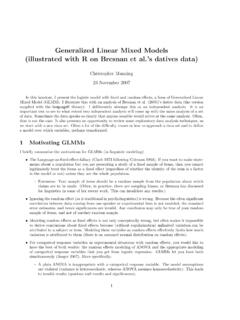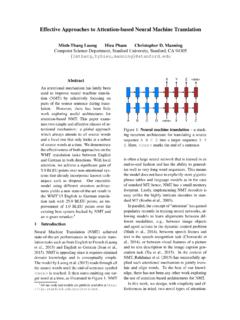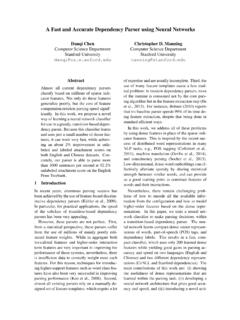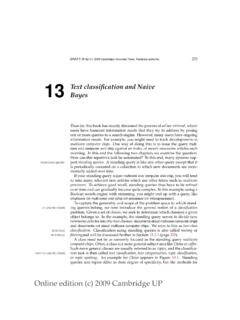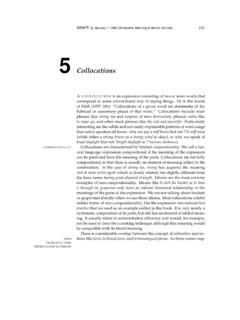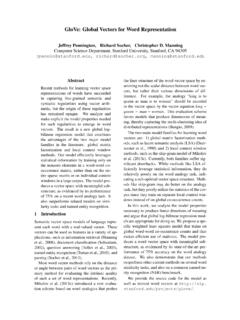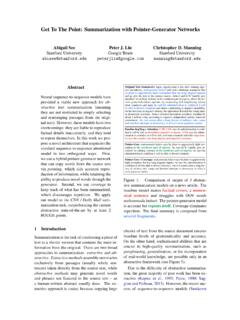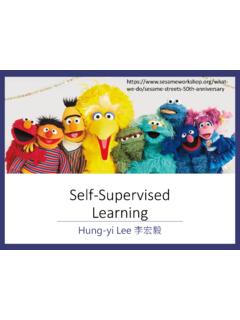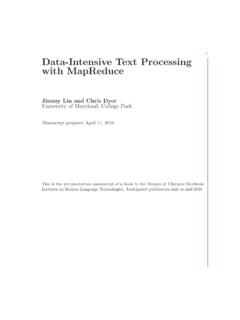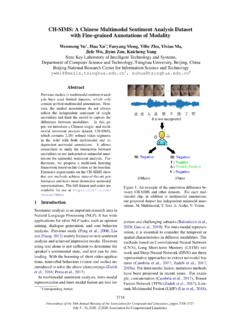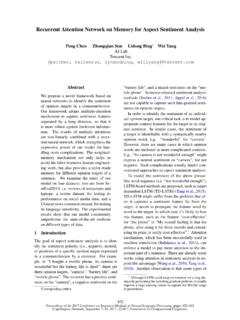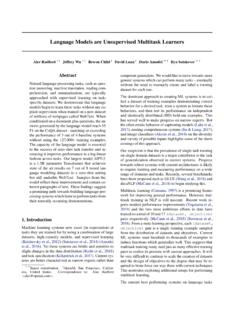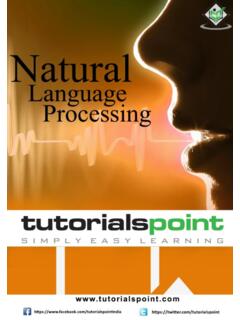Transcription of BERT: Pre-training of Deep Bidirectional Transformers for ...
1 BERT: Pre-training of Deep Bidirectional Transformers for Language Understanding( Bidirectional Encoder Representations from Transformers )Jacob DevlinGoogle AI LanguagePre-training in NLP Word embeddings are the basis of deep learning for NLP Word embeddings (word2vec, GloVe) are often pre-trained on text corpus from co-occurrence statisticsking[ , , , ..]queen[ , , , ..]the king wore a crownInner Productthe queen wore a crownInner ProductContextual Representations Problem: Word embeddings are applied in a context free manner Solution: Train contextual representations on text corpus[.]
2 ]open a bank accounton the river bankopen a bank account[ , , , ..]on the river bank[ , , , ..]History of Contextual Representations Semi-Supervised Sequence Learning, Google, 2015 Train LSTML anguage ModelLSTM<s> on Classification TaskHistory of Contextual Representations ELMo: Deep Contextual Word Embeddings, AI2 & University of Washington, 2017 Train Separate Left-to-Right and Right-to-Left LMsLSTM<s>openLSTM openaLSTM abankApply as Pre-trained Embeddings LSTM open<s>LSTM aopenLSTM bankaopenabankExisting Model ArchitectureHistory of Contextual Representations Improving Language Understanding by Generative Pre-training , OpenAI, 2018 Transformer<s>openopenaabankTransformerTransformerPOSI TIVEFine-tune on Classification TaskTransformer<s>openaTransformerTransformerTrain Deep (12-layer)
3 Transformer LMProblem with Previous Methods Problem: Language models only use left context or right context, but language understanding is Bidirectional . Why are LMs unidirectional? Reason 1: Directionality is needed to generate a well-formed probability distribution. We don t care about this. Reason 2: Words can see themselves in a Bidirectional 2<s>Layer 2openLayer 2openLayer 2aLayer 2aLayer 2bankUnidirectional contextBuild representation incrementallyLayer 2<s>Layer 2openLayer 2openLayer 2aLayer 2aLayer 2bankBidirectional contextWords can see themselves Unidirectional vs.
4 Bidirectional ModelsMasked LM Solution: Mask out k% of the input words, and then predict the masked words We always use k = 15% Too little masking: Too expensive to train Too much masking: Not enough contextthe man went to the [MASK] to buy a [MASK] of milkstoregallonMasked LM Problem: Mask token never seen at fine-tuning Solution: 15% of the words to predict, but don t replace with [MASK] 100% of the time. Instead: 80% of the time, replace with [MASK]went to the store went to the [MASK] 10% of the time, replace random wordwent to the store went to the running 10% of the time, keep samewent to the store went to the storeNext Sentence Prediction To learn relationships between sentences, predict whether Sentence B is actual sentence that proceeds Sentence A, or a random sentenceInput Representation Use 30,000 WordPiece vocabulary on input.
5 Each token is sum of three embeddings Single sequence is much more Architecture Multi-headed self attention Models context Feed-forward layers Computes non-linear hierarchical features Layer norm and residuals Makes training deep networks healthy Positional embeddings Allows model to learn relative positioningTransformer encoderModel Architecture Empirical advantages of Transformer vs. == no locality bias Long-distance context has equal opportunity multiplication per layer == efficiency on TPU Effective batch size is number of words, not sequencesX_0_0X_0_1X_0_2X_0_3X_1_0X_1_1X _1_2X_1_3 WX_0_0X_0_1X_0_2X_0_3X_1_0X_1_1X_1_2X_1_ 3 WTransformerLSTMM odel Details Data: Wikipedia ( words) + BookCorpus (800M words) Batch Size: 131,072 words (1024 sequences * 128 length or 256 sequences * 512 length) Training Time: 1M steps (~40 epochs) Optimizer: AdamW, 1e-4 learning rate, linear decay BERT-Base.
6 12-layer, 768-hidden, 12-head BERT-Large: 24-layer, 1024-hidden, 16-head Trained on 4x4 or 8x8 TPU slice for 4 daysFine-Tuning ProcedureGLUE ResultsMultiNLIP remise: Hills and mountains are especially sanctified in : Jainism hates : ContradictionCoLaSentence: The wagon rumbled down the : AcceptableSentence: The car honked down the : UnacceptableSQuAD Only new parameters: Start vector and end vector. Softmax over all Use token 0 ([CLS]) to emit logit for no answer . No answer directly competes with answer span.
7 Threshold is optimized on dev Run each Premise + Ending through BERT. Produce logit for each pair on token 0 ([CLS])Effect of Pre-training Task Masked LM (compared to left-to-right LM) is very important on some tasks, Next Sentence Prediction is important on other tasks. Left-to-right model does very poorly on word-level task (SQuAD), although this is mitigated by BiLSTME ffect of Directionality and Training Time Masked LM takes slightly longer to converge because we only predict 15% instead of 100% But absolute results are much better almost immediatelyEffect of Model Size Big models help a lot Going from 110M -> 340M params helps even on datasets with 3.
8 600 labeled examples Improvements have not asymptoted Effect of Masking Strategy Masking 100% of the time hurts on feature-based approach Using random word 100% of time hurts slightlyMultilingual BERT Trained single model on 104 languages from Wikipedia. Shared 110k WordPiece vocabulary. XNLI is MultiNLI translated into multiple languages. Always evaluate on human-translated Test. Translate Train: MT English Train into Foreign, then fine-tune. Translate Test: MT Foreign Test into English, use English model. Zero Shot: Use Foreign test on English Baseline - Translate Baseline - Translate - Translate - Translate - Zero Training seq2seq model to generate positive questions from context+ transform positive questions into negatives ( , no answer /impossible).
9 Result: + F1/EM score, new state-of-the-art. Synthetic Training seq2seq model on Wikipedia. Encoder trained with BERT, Decoder trained to decode next model on SQuAD Context+Answer Question Ceratosaurus was a theropod dinosaur in the Late Jurassic, around 150 million years ago. -> When did the Ceratosaurus live ? model to predict answer spans without questions. Ceratosaurus was a theropod dinosaur in the Late Jurassic, around 150 million years ago. -> {150 million years ago, 150 million, theropod dinsoaur, Late Jurassic, in the Late Jurassic}Synthetic Training answer spans from a lot of Wikipedia paragraphs using model from (3) output of (4) as input to seq2seq model from (2) to generate synthetic questions: Roxy Ann Peak is a 3,576-foot-tall mountain in the Western Cascade Range in the state of Oregon.
10 What state is Roxy Ann Peak in? with baseline SQuAD system to throw out bad questions. Roxy Ann Peak is a 3,576-foot-tall mountain in the Western Cascade Range in the state of Oregon. What state is Roxy Ann Peak in? (Good) Roxy Ann Peak is a 3,576-foot-tall mountain in the Western Cascade Range in the state of Oregon. Where is Oregon? (Bad) generate strong negatives questions from other paragraphs of same state is Roxy Ann Peak in? When was Roxy Ann Peak first summited? span of text with other span of same type (based on POS tags).
